Have you ever come across content like photos, videos, or audio featuring public figures that turned out to be fake? Be careful, as it could be a deepfake!
Deepfake refers to fake photos, videos, and audio that are reproduced from their original sources using artificial intelligence (AI). Deepfake combines the words "deep learning" and "fake," referring to video or audio content that has been manipulated with AI technology to appear very realistic. Try looking on social media or video platforms, there is a plethora of deepfake content out there.
Deepfake is indeed entertaining. However, because it has become increasingly widespread, deepfake has the potential to deceive or generate fake news (hoaxes). How can you identify deepfake content? Well, this article will explain it.
Detecting Deepfake Content
Deepfake technology is becoming more advanced. Identifying its content is becoming increasingly difficult. However, there are several things that can be done to identify artificially produced deepfake content.
1. Unnatural Movements
Try to observe facial expressions and movements in some deepfake videos. The movements are unnatural. Facial and body movements in real humans are more natural and fluid, while in deepfake, they appear jerky and unnatural. In fact, most deepfakes display unnatural and unsynchronized movements among body parts.
2. Audio and Video Desynchronization
Synchronization between audio and video is another characteristic of potential deepfake. Genuine videos have consistent synchronization between visual and audio elements. However, deepfakes often struggle to synchronize these aspects, resulting in differences between audio and video.
3. Eye Movement and Blink Detection
Since deepfake is AI-generated, eye movement or blinking is usually unnatural. Unfortunately, increasingly sophisticated deepfakes make eye movement detection difficult. Using detection algorithms to monitor eye movement and blinking in video subjects can help identify manipulation.
4. Inconsistent Colors and Shadows
Inconsistencies in color and shadows can help identify deepfake videos. This occurs because AI still struggles to replicate lighting conditions and shadows in the real world accurately. Sometimes, colors and shadows are also distorted.
5. Voice and Background Analysis
Analyzing the voice of the deepfake subject and the background voice in the video is also an important technique in detecting deepfake content. Inconsistent voice changes or mismatches between lip movements and the resulting voice can be indicators of manipulation. Additionally, detailed voice analysis in the background of the video can help identify altered videos.
Currently, verification and authentication technologies can prevent deepfake access in the form of Presentation Attacks or Injection Attacks. However, these technologies also compete with increasingly sophisticated deepfakes.
Various Types of Deepfake Attacks
Deepfake in social media may appear common and often. But what about deepfake in verification process of mobilie application?
First, let's understand the various uses of deepfake for fraud. Deepfake attacks are divided into two types: presentation attacks and injection attacks.
1. Presentation AttackA presentation attack is an attempt to defraud biometric authentication systems by presenting fake biometrics. These biometrics can be in the form of photos, masks, or other disguises to trick biometric systems. The goal is illegal access to security systems. Deepfake technology can create images or videos that are very realistic and taken from real people.
2. Injection AttackThis type of attack is more sophisticated than Presentation Attack. It involves injecting code or malicious commands into biometric systems to gain unauthorized access and manipulate the system. For example, scammers inject deepfake audio into voice recognition systems for verification. Similar to Presentation Attack, the goal of this attack is to gain illegal access to security systems.
As part of the data protection solution, VIDA offers the latest technology development called VIDA Deepfake Shield. In this regard, VIDA has been strengthened with the ability to control the entire process towards biometric system access, so that any fraud loophole can be quickly prevented. Facing evolving cyberattacks, adopting solutions like VIDA Deepfake Shield is no longer an option but a necessity.

.png)


